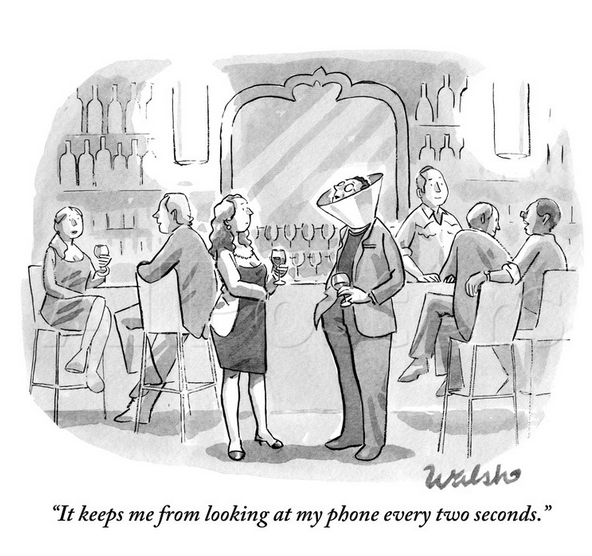This morning, as I lay on my back in yoga class on an escape far from home, glancing up through the window in the yurt ceiling, I saw out of the corner of my eye a man in the fetal position on his yoga mat stealthily checking his phone. I immediately felt outrage (since that’s the in-vogue emotion for such situations), yet I too am guilty of endlessly checking my phone– in front of my children, at the movie theater, even when crossing the street. Ugh. I always have some seemingly critical reason to be online: I need to confirm a pick-up time, make sure there’s no word from the babysitter, or quickly respond to a work email so it’s off my plate. Yes, I admit, I am unable to disconnect.
It seems we have reached a point of total wireless abandon. Facebook recently announced it will acquire WhatsApp for nineteen billion dollars. Why? Because it taps into our insatiable appetite for non-stop social connection. Every day, more than a million people install this app and start chatting. According to the McKinsey Global Institute, the average person dedicates thirteen hours a week to email–reading, responding, deleting, and sorting it. And we check our phones 110 times a day on average, once every six seconds during peak times, with some users unlocking their devices up to 900 times a day, according to Android app Locket.
It makes me nostalgic to think back to what it was like without wireless communication in my college days. The quiet moments walking home from classes in the snow, or chatting endlessly with friends in the dorms . . . there were no texts to respond to or tweets to re-tweet. But it’s not that I wouldn’t have loved the efficiency and beauty of such easy communication, to meet up with friends across campus or to send my parents a picture of the bell tower on the way to class (or my car being towed for failing to pay parking tickets), so they knew I was thinking of them. And recently I had my first “Facebook” birthday experience, which I confess touched me, hearing from so many friends, old and new.
Today, we all have wireless data plans for our online use, but we have no intention or plan for how to be offline. We are connected from morning till night (and, sigh, I have rolled over in the middle of the night to check my phone, too).
As my children enter this wireless world of Facebook, WhatsApp, Instagram, and Snapchat, it’s painfully clear that we need a meaningful plan for finding a balance for all of us. I don’t want my children imitating my rude habit of checking my phone in mid-sentence, staying online rather than reading a book, or worse, learning to drive without the discipline to leave their phone out of reach. In China, they now have 400-plus, prison-like Internet Addiction Treatment Centers for teens, not unlike boot camp for drug addicts. We need ways to prevent our teens from spending more time in virtual reality than reality before it becomes an addiction. It has to start at home. We, as parents, need to set a better example for our children.
This is not to ignore the great need for some after-hour online controls for the work place as well (it is becoming hard to imagine a world where a client or colleague does not email you in the evenings or weekend). In Germany, in an effort to prevent employees from burning out, the Labor Ministry and firms such as BMW, Volkswagon, and Puma have imposed after-hour email restrictions. In contrast, in the U.S., instead of “minimum intervention” into the free time of workers, our culture seems to be moving toward total obliteration of the divide between personal time and work.
But we need to start to improve the situation, first, by looking at our role as parents at home. We need to choose mindfully to limit our time online, taking a productive step toward helping our children find a balance. The ways to limit online time are endless, but the key is intentionally making a plan:
(1) delineating tech-free zones in our home, such as the kitchen and bedrooms;
(2) scheduling family time offline;
(3) mandating daily blackout hours;
(4) taking a day a month offline (I have never tried this, and it would be extremely challenging, which makes me think I definitely need to do it);
(4) pre-defining schedules for checking messages rather than continuously being online; and
(5) using tools such as Page Addict to monitor your internet time and cut you off when you have exceeded specified amounts of time on sites such as Facebook.
Placing some parental controls on us parents will give us credibility as we help our children navigate the online world. But now, excuse me as I pause to photograph the sunset on my beautiful escape . . . so I can post it on Facebook.
Posted on 3/6/2014
Katherine Eskovitz began her career as a trial lawyer before founding little BLUEPRINT. A graduate of Yale Law School and Cornell University, Katherine practiced law for seventeen years as a federal prosecutor and partner in a national law firm before turning her courtroom skills, and experience as a former speechwriter, to writing for a new audience: children. Katherine’s Have a Plan Books, available at www.littleBLUEPRINT.com, are the result of years of research on child development and brain science, writing and collaboration with experts, and passion for photography. A native New Yorker, Katherine lives in Santa Monica, California with her husband and three children.














Leave A Comment
You must be logged in to post a comment.